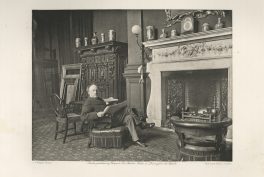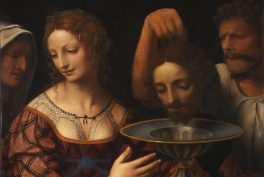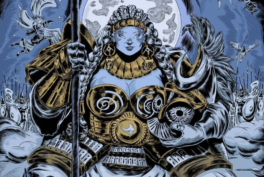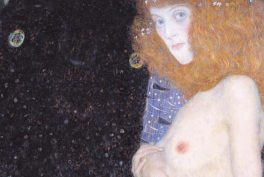Summary
- Opened in 1955 at MoMA, The Family of Man is history’s most widely viewed photographic exhibition.
- Edward Steichen organized the exhibition, but the American photographer Dorothea Lange played a major role in its legendary success.
- Steichen took an interest in Lange’s work for the Farm Security Administration in 1937.
- In 1952, Steichen reached out to Lange about helping organize The Family of Man exhibition. Lange encouraged other photographers to participate and provided themes which Steichen used in the exhibition’s layout.
- Steichen selected nine of Lange’s photographs for the exhibition and accompanying book. Four of these feature children and deal with the relationship with their parents.
- In First Born, Lange shares an intimate moment from her own family—her son John holding her grandson Gregor.
- Migrant Mother depicts the tragic impact of the Great Depression and the mother’s determination to protect her children.
- In Mother and Child, Lange shows detachment between mother and her child.
- Damaged Child is a haunting portrayal of a poor, undernourished girl.
- Lange’s contributions to The Family of Man exhibition reflect her desire to use photography to explore human relations.
The Family of Man photography exhibition opened at the Museum of Modern Art (MoMA) in New York on January 24, 1955, which means that January 2025 marks the 70th anniversary of this landmark exhibition. Organized by Edward Steichen (the then Director of the Museum’s Department of Photography), the exhibit included 503 photographs representing nearly 70 countries. Although these photographs portrayed people from many different countries, they all celebrated the universal nature of everyday life throughout the world. The Family of Man still holds the record as the most widely viewed photographic exhibition in history, with over nine million people seeing the exhibit in person and many more people seeing the images as presented in the accompanying book.

Cover of The Family of Man catalog featuring Piper photograph by Eugene Harris, 1955, Ridge Press, Museum of Modern Art, New York. City, NY, USA. Museum’s website.
Over the years, The Family of Man exhibition has attracted a great deal of publicity. However, despite all the coverage of the exhibit, scant attention has been paid to the contributions of Dorothea Lange (1895–1965) to the exhibition. The 70th anniversary is a fitting time to recognize Lange’s key role in helping Edward Steichen make this project a reality as well to discuss the importance of the nine Lange photographs that Steichen included in the exhibit.
Dorothea Lange’s Connections to Edward Steichen
Edward Steichen’s interest in Dorothea Lange’s photographs can be traced back to 1937, ten years before he became the director of MoMA’s Department of Photography. Steichen took note of a photographic project launched by the Farm Security Administration (FSA) in 1937. The purpose of the project was to create a photographic record of American farm life during the Depression.
Dorothea Lange was one of the leading FSA photographers. Steichen especially liked Lange’s powerful photographs of sharecroppers in Alabama. He praised Lange’s FSA photographs in a feature section he prepared for U.S. Camera Annual of 1939. In 1949 Steichen included a selection of Lange’s photographs in an exhibit he curated titled Sixty Photographs by Six Women for MoMA. Over the course of their interactions, Steichen and Lange forged a professional alliance in part because they both valued photographs that tell stories and provide insights into the human experience.
The Family of Man
Steichen first conceived of the idea behind The Family of Man exhibition in 1949, although he had not yet come up with the title for the exhibit. In September 1949, he sent a letter to Lange in which he told her about his “tentative plans for a national exhibition revolving around the themes of Human Relations and Human Rights. It is all still in the research stage.”1 A few years went by, but in 1952 Steichen officially began organizing The Family of Man exhibition. His goal was to create an exhibition of photographs “portraying the universal elements and emotions and the oneness of human beings throughout the world.”2

Installation view of The Family of Man exhibition, 1955, Museum of Modern Art, New York City, NY, USA. Photograph by Ezra Stoller. Museum’s website.
While still in the very beginning stages of this project, he again reached out to Lange, and she immediately offered to reach out to other photographers to contribute to this exhibit. In a letter written on July 25, 1952, in response to her offer, he wrote, “… you have been appointed, and have accepted, the western section of the United States.”3 Steichen’s reference to the western United States reflects the fact that Lange was then living in Berkeley, California.

Installation view of The Family of Man exhibition, 1955, Museum of Modern Art, New York City, NY, USA. Photograph by Ezra Stoller. Museum’s website.
Recalling the early planning for the exhibit, Wayne Miller (Steichen’s assistant at MoMA) commented on Lange’s efforts to help Steichen with the project:
Dorothea Lange was in touch with Steichen, and she suggested we get together a group of photographers from the Bay area and talk to them about the exhibition and encourage their participation in supplying photographs for the show. This was done, and Steichen came out about the time of his birthday in March of 1953. … He was still exploring the concept, so he was bouncing ideas off these photographers, and so many of them didn’t understand his vision. … Dorothea Lange was gung-ho because she understood and shared his dreams and ideas.
Penelope Nevin: Steichen: A Biography, 1997, New York, p. 638.

Installation view of The Family of Man exhibition, 1955, Museum of Modern Art, New York City, NY, USA. Photograph by Ezra Stoller. Museum’s website.
In addition to arranging the California meeting, Dorothea Lange sent in 1953 a general announcement to photographers whom she knew under the heading “A SUMMONS TO PHOTOGRAPHERS ALL OVER THE WORLD to participate in an exhibit under the title THE FAMILY OF MAN.” In this announcement, she wrote,
Under this simple universal theme, we propose to show Man to Man across the world. Here we hope to reveal by visual images Man’s dreams and aspirations, his strength, his despair under evil. If photography can bring these things to life, this exhibition will be created in a spirit of passionate and devoted faith in Man.
John Szarkowski: “The Family of Man,” in The Museum of Modern Art at Mid-Century: At Home and Abroad, Ed. John Elderfield, 1994, New York, p. 25.

Installation view of The Family of Man exhibition, 1955, Museum of Modern Art, New York City, NY, USA. Photograph by Ezra Stoller. Museum’s website.
Dorothea Lange included with her announcement a list of words that she thought might inspire photographers: including love, birth, death, family, work, home, worship, peace, conflict, beauty, fear, hope, and dream. Lange’s word list appealed to Steichen. In fact, the words from her list became the themes that he used when organizing the photographs in the exhibition.4

Installation view of The Family of Man exhibition, 1955, Museum of Modern Art, New York City, NY, USA. Photograph by Ezra Stoller. Museum’s website.
Lange remained in frequent contact with Steichen throughout the process of organizing this exhibition. In her communications with Steichen, Lange made many suggestions related to the exhibition. Steichen implemented some of her suggestions, but certainly not all of them. More important than her suggestions, however, were her words of encouragement. In his essay on the history of The Family of Man exhibition, John Szarkowski wrote:
It is impossible to know how large an influence Dorothea Lange had on The Family of Man, but it might have been great—not, perhaps, by virtue of her specific suggestions, but by holding Steichen’s feet to the fire, by insisting that he settle for nothing less than a work of vaulting ambition.
John Szarkowski: “The Family of Man,” in The Museum of Modern Art at Mid-Century: At Home and Abroad, Ed. John Elderfield, 1994, New York, p. 21.
Dorothea Lange’s Photographic Contributions to the Exhibition
Lange also submitted her own work for Steichen and Miller to be considered for inclusion in the exhibition, and they ultimately selected nine of her photographs to appear in both the exhibition and the book. These photographs cover a range of topics; including the lives of farm workers, the interactions of couples, and the experiences of people working with their hands. Four of the most memorable of these nine photographs feature children. Each of these childhood-related photographs presents a moving image on its own, but when viewed together, they tell a larger story about the relationships between children and their parents.
1. First Born, 1952

Dorothea Lange, First Born, Berkley, California, 1952, © The Dorothea Lange Collection, Oakland Museum of California, Oakland, CA, USA. Museum’s website.
In the photograph titled First Born, Dorothea Lange shares an intimate moment from her own family history. The photograph is of her son, John, holding her newborn grandson, Gregor. Taken in Lange’s home in Berkeley, California, in 1952, the photograph shows a young father tenderly holding a baby wrapped securely in a blanket. The father looks both proud and a little bewildered. The photograph conveys a sense of parental love. In the context of The Family of Man exhibition, First Born has come to be seen as a representation of fatherhood.
2. Migrant Mother, 1936

Dorothea Lange, Migrant Mother, Nipomo, California, 1936, Museum of Modern Art, New York City, NY, USA. Museum’s website.
The exhibit also includes Migrant Mother, Dorothea Lange’s most famous photograph. Lange took this photograph in Nipomo, California, in 1936 while working for the Farm Security Administration. Much has been written about this photograph, but most of the commentary focuses on the expression on mother’s careworn face. Not as much has been written about the two children huddled behind their mother or the baby sleeping in mother’s lap.
As depicted in the photograph, these children are turning to their mother for security. There is no space between the children and their mother. The two older children appear to be hiding their faces, perhaps from the photographer or perhaps from some other perceived threat. It is as if these children see their mother as their protective bulwark in an otherwise hostile world. This photograph depicts the tragic impact of that the Great Depression had on so many families, but it also shows the mother’s steely determination to protect her children.
3. Mother and Child, 1952

Dorothea Lange, Mother and Child, San Francisco, 1952, Museum of Modern Art, New York City, NY, USA. Museum’s website.
The exhibition includes another Dorothea Lange photograph of a mother living in California, but these mothers are presented as living in completely different worlds. Called Mother and Child, San Francisco, this photograph dates from 1952. It shows a stylishly dressed mother walking down a commercial street in San Francisco with her equally well-dressed child trailing behind at a distance.
Unlike the children depicted in Migrant Mother, the child in this photograph seems detached from his mother. The child is walking near his mother, but they do not seem to be truly walking together. For her part, the mother does not appear to be paying any attention to the child. The child in this photograph is not suffering from deprivation, but the child is depicted as being alone at least in the moment when the photograph was taken.
4. Damaged Child, 1936

Dorothea Lange, Damaged Child, Shacktown, Elm Grove, Oklahoma, 1936, Museum of Modern Art, New York City, NY, USA. Museum’s website.
Of Dorothea Lange’s four child-related photographs from The Family of Man exhibition, the saddest is Damaged Child. Lange took this photograph in Elm Grove, Oklahoma, in 1936. A child of the Dust Bowl, the young girl in the photograph is dirty, undernourished, and poorly dressed. Her eyes are almost hidden in that dark and haunting hollows that dominate her face. Her expression exudes both anger and fear. The photograph depicts the girl standing by herself, looking uncared for and alone.
Taken together, these four child-related images speak to the importance of family in children’s lives. Lange’s deep interest in the complexities of family dynamics helps explain why she was so committed to helping Steichen make The Family of Man exhibition a reality. For her, this project meant more than organizing a large exhibition of photographs. It reflected her desire to use photography to explore human relations, including the relationships between children and parents.
Dorothea Lange fully understood Steichen’s desire that The Family of Man exhibition should focus on the photographs and not the photographers, so it did not trouble her that her many contributions to the exhibition were not highlighted in the publicity surrounding the exhibition. She took tremendous satisfaction in the success of The Family of Man, and that was good enough for her. However, as we mark the 70th anniversary of this exhibition, it is time to recognize that Lange played a major role in making The Family of Man such a landmark achievement in the history of photography.
Author’s bio
Mark I. West is a professor of English at the University of North Carolina at Charlotte. He has held many administrative positions at UNC CHarlotte including the Interim Chair of the Department of Art and Art History.




